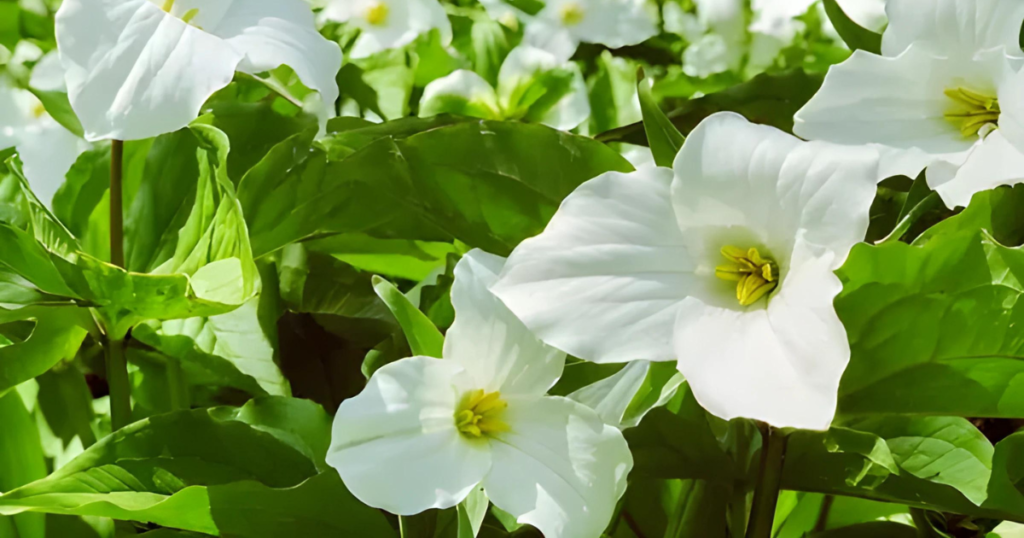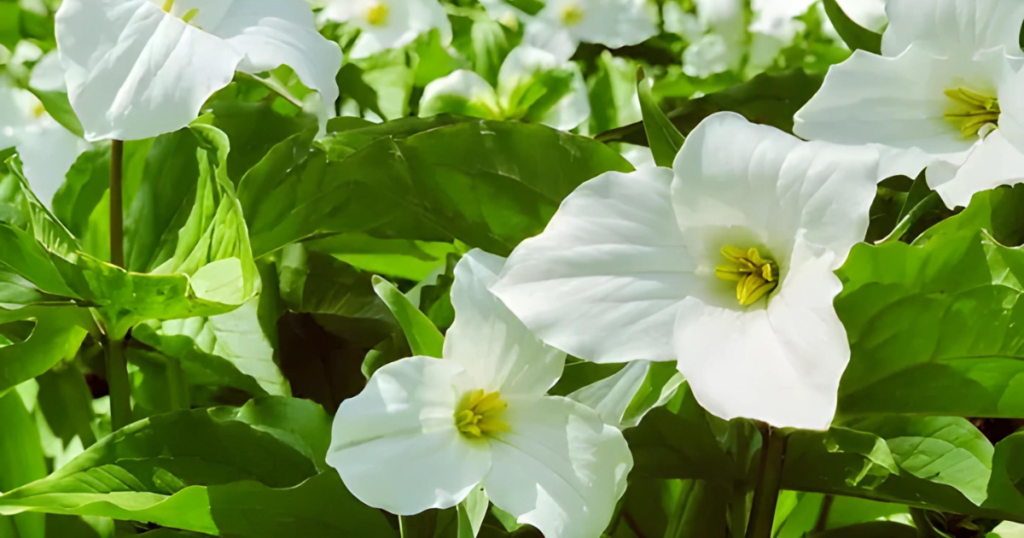Introduction
As the winter frost melts away and the first warm breezes of spring rustle through the forests, a true natural marvel begins to reveal itself among the leaf litter and dense underbrush. Emerging almost magically, the pristine white trillium flower unfurls its delicate triple-petaled blooms, captivating all who bear witness to its ethereal beauty.
This elusive and highly coveted wildflower, known scientifically as the great white trillium (Trillium grandiflorum), has enchanted botanists, nature enthusiasts, and indigenous cultures for centuries with its striking elegance and intricate life story. From its brief yet radiant flowering to its unique reproductive cycle spanning years, the white trillium is a living embodiment of nature’s wondrous complexity and resilience.
Join us as we delve into the fascinating world of this cherished North American perennial, uncovering its rich history, symbolic significance, and vital efforts to protect its increasingly fragile habitat.
Read More: DIGITAL NEWS PLANET
The Allure of the White Trillium Flower
At first glance, the white trillium may appear deceptively simple – a solitary stalk rising 12-18 inches from the forest floor, adorned with a single exquisite bloom and whorled leaves. Yet, upon closer inspection, the flower’s true majesty is revealed in its intricate architectural design and pristine white coloration.
The white trillium flower is a radiant vision. Its three crisp, ovate petals surround a striking trio of green sepals that flare outward like a regal crown. Its delicate anthers and stigma form a captivating central structure, while the broad, whorl-patterned leaves provide a lush emerald backdrop that accentuates the bloom’s luminous beauty.

“The white trillium is nature’s purest expression of spring,” remarks esteemed botanist Dr. Sarah Ellison. “Its simple yet perfectly sculpted form and immaculate white hue convey a sense of renewal, innocence, and the awakening of the natural world after winter’s long slumber.”
However, as breathtaking as this wildflower’s appearance may be, its true magic lies in the incredible journey it undertakes throughout its intricate life cycle. This process can span well over a decade from initial germination to its first bloom.
The Patient Odyssey: Germination to Glorious Bloom
For the white trillium, the path to flowering is an exercise in profound patience and resilience. The wildflower’s incredible life story begins with a single seed, often lying dormant in the rich, loamy soil of its preferred woodland habitat for two to three years before conditions are ideal for germination.
Once sprouted, the tender seedling allocates all its energy to developing a robust root system and a solitary leaf, remaining this way for several more years as it slowly builds strength. It’s not until the fifth or sixth year that the young plant unveils its second leaf, with subsequent years seeing the addition of another emerald tier.
“The white trillium’s extended vegetative phase is crucial for accumulating the necessary resources to support its phenomenal blooming event years down the road,” explains Dr. Ellison. “It’s an incredible testament to nature’s brilliant strategies for conservation and survival.”
Finally, after a staggering minimum of 7-10 years of steadfast growth, the great white trillium reaches reproductive maturity and produces its first breathtaking floral display – but even this phase is remarkably brief. The exquisite triple-petaled blooms persist for only 5-10 fleeting days before withering, potentially aided by insect pollinators in setting fruit to perpetuate the cycle anew.
An Elusive Marvel Born of Demanding Environments
While the white trillium flower’s delicate splendor and seeming meekness may belie an assumption of commonality, these wildflowers are increasingly rare and elusive gems in today’s landscape. Their highly specialized environmental requirements make naturally occurring specimens an ever-dwindling treasure to behold.
“White trillium absolutely cannot persist in disturbed or developed environments,” states conservationist Laura Simpkins. “They have an incredibly narrow ecological niche that demands dense, undisturbed woodlands with particular soil compositions and moisture levels.”
The wildflower thrives primarily in shaded, rich humus forests found across eastern North America, spanning from the Great Lakes region down through the Appalachians and into Georgia and Mississippi. Here, filtered sunlight, damp earth, and thick coatings of decomposing leaves provide the ideal conditions for germination and growth.
However, rampant deforestation, urban encroachment, and aggressive landscaping practices have increasingly compromised the tremendous white trillium’s native habitats over the past century. Many isolated populations have vanished, with others teetering on the brink of localized extinction.

“It’s absolutely heartbreaking to witness once-thriving trillium colonies disappear due to careless human impacts,” laments Simpkins. “Which is why defending and preserving their remaining environmental footholds has become a crucial conservation priority for our generation.”
The White Trillium’s Symbolic Tapestry: Tales and Traditions
Beyond its exquisite beauty and incredible life cycle, the white trillium has held profound symbolic and cultural significance for the indigenous tribes and early European settlers who called North America home. Its pristine triple-petaled form became interwoven into a vibrant tapestry of folklore, traditions, and reverence for the natural world.
For many Native American nations like the Haudenosaunee and Anishinaabe, the white trillium flower embodied the sacred concept of triplicity and harmony between body, mind, and spirit. Its delicate beauty further represents the essence of purity, fresh beginnings, and spiritual awakening in the spring season.
“The arrival of the white trillium marked the true renewal of the earth after winter’s harsh grasp,” explains indigenous scholar Thomas Deerheart. “Its appearance became a celebrated rite, with many tribes using the flowers in rituals and ceremonies to honor the land’s rebirth.”
As European settlers pushed westward in the 17th and 18th centuries, they, too, became enamored with the ephemeral splendor of the white trillium. Emerging from the dreary winter months, the wildflower’s radiant blooms were a cherished harbinger of spring’s long-awaited arrival.
Among early colonial communities, it became fashionable for young lovers to venture into the woodlands and gift one another with white trillium flowers – solidifying the bloom’s romantic associations. This courtship tradition of “trillium hunting” persisted for generations, with entire festivals and events centered around celebrating the precious wildflower each spring.
The White Trillium’s Enduring Environmental Symbolism
While the white trillium flower’s mystique and romance have captivated humans for centuries, in more recent times, it has emerged as a powerful emblem of environmental conservation efforts aimed at protecting its biodiversity and fragile native habitats.
Across many eastern states and Canadian provinces where the wildflower still thrives, its distinctive three-petaled structure has become an unofficial symbol for ecological awareness. The white trillium’s elegant floral design can be found gracing environmentally-themed license plates and apparel lines aimed at promoting land stewardship, and it even serves as the official emblem of some state wildflower associations.
“The white trillium is perfect for galvanizing conservation support,” asserts naturalist Jenny Holzer. “Not only does its rarity make it worth preserving for future generations to appreciate, but its very existence is a visible reminder of how crucial it is to safeguard pristine, undisturbed natural spaces.”
The White Trillium’s Celebrity Advocates
In the fight to raise awareness and preserve the white trillium’s future, a handful of high-profile advocates have eagerly taken up the mantle of championing this enchanting wildflower. Leveraging their global platforms, these unlikely spokespeople are using their influence to shine a light on the importance of environmental conservation.
Perhaps no one has embraced the great white trillium quite like international golfing superstar Nelly Korda. The world’s top-ranked female player has become an ardent and outspoken admirer of the delicate bloom, frequently sharing photos of her “trillium hunting” adventures on social media.
“There’s just something so pure and magical about the white trillium,” Korda gushes. “It reminds me of the importance of remaining grounded, appreciating nature’s small miracles, and doing whatever I can to protect them for future generations.”
The 24-year-old American has even featured the flower’s iconic three-petal design in her athletic apparel, essentially transforming the once-obscure trillium into her own personal brand ambassador on the golf course.
“If I can expose the white trillium to millions of new fans worldwide and maybe inspire some of them to learn about its preservation, then I’ll feel like I’ve made a real impact beyond just my sport,” Korda states with conviction.
In the entertainment realm, acclaimed actor and environmentalist Edward Norton has also prominently championed the white trillium’s cause through his involvement with an ambitious public wildflower preservation campaign called “Project Trillium.” Launched in 2018, the initiative aims to map all remaining trillium populations, acquire key land parcels for permanent protection, and establish ConnectTheFlora.com – an online database of flowering plant biodiversity across North America.
“The great white trillium is an absolutely exquisite species, but its incredible rarity underscores how systematically we’ve devastated our natural environments,” cautions Norton. “Through Project Trillium, we can start to reverse that tide by identifying and defending the wildflower’s surviving sanctuaries, one acre at a time.”
With his passionate advocacy and ambitious vision, Norton has successfully elevated the white trillium’s plight into the cultural mainstream – serving as a relatable ambassador for the importance of conservation.
The White Trillium’s Fight for the Future
While the great white trillium may seem a modest and unassuming wildflower, its tenacious existence and enduring allure have transformed it into a valid symbol of resilience, rebirth, and the perseverance of nature’s wondrous complexity.
As urban development and deforestation continue to infringe upon the wildflower’s remaining footholds, it has become a race against time to defend and preserve every surviving colony, no matter how isolated or seemingly insignificant. Numerous state, provincial, and national initiatives have arisen with the sole purpose of identifying, mapping, and acquiring critical parcels of trillium habitat for permanent protection.
“We’ve already lost so many distinct populations of this incredible plant forever,” laments Dr. Ellison solemnly. “If we don’t take concerted action now to safeguard its native environments, we risk watching the white trillium disappear from entire regions within our lifetime.”
Botanical gardens and conservation groups have also rallied around the wildflower, launching captive propagation and reintroduction programs aimed at bolstering vulnerable trillium communities. However, the widespread extraction and commercialization of the flowers themselves remains a grave threat that reputable organizations vehemently discourage.

“Engaging in unethical white trillium poaching is incredibly shortsighted and damaging,” warns Simpkins adamantly. “Not only do such actions deplete the wildflowers’ natural seedbanks, but they also irreparably disrupt the delicate ecological balance of their micro-habitats.”
As the planet’s biodiversity continues declining at an alarming rate, the plight of the great white trillium has emerged as a poignant reminder of how inextricably our very existence remains intertwined with nature’s fragile rhythms. By fighting for this delicate wildflower’s preservation, we can awaken a more profound reverence for the urgency of environmental conservation as a whole.
Conclusion
The ethereal beauty and incredible life story of the white trillium have captivated botanists, nature enthusiasts, and indigenous cultures for centuries. This delicate, triple-petaled wildflower stands as a true marvel of nature – a precious living embodiment of resilience, patience, and the miraculous cycles that sustain all life on our planet.
From its remarkably elusive and specialized habitat requirements to its fascinating reproductive odyssey spanning over a decade, the great white trillium demands our respect and adoration. Its pristine form and ephemeral blooming have become woven into a rich tapestry of symbolism, folklore, and cherished traditions.
However, the wildflower’s future existence remains threatened by human-driven forces of deforestation, urban sprawl, and environmental degradation. As we continue infringing upon the trillium’s remaining sanctuaries, its very survival has emerged as a powerful catalyst for conservation awareness on a broader scale.
Through the vigorous efforts of committed organizations, botanists, indigenous leaders, and unlikely celebrity advocates, the white trillium flower may yet inspire a profound awakening within humanity. Its precarious plight underscores the urgency of recognizing and defending nature’s stunning complexity and biodiversity before it’s too late.
By cherishing the tremendous white trillium and heeding its poignant lessons about patience, reverence, and the delicate balance of all life, perhaps we can rediscover our vital role as humble stewards and caretakers of this planet we all share.
-
What is the scientific name for the white trillium?
The scientific name for the white trillium is Trillium grandiflorum. It is also commonly known as the great white trillium or large-flowered trillium.
-
Where do white trilliums naturally occur?
White trilliums are native to eastern North America, primarily found in the deciduous forests of the Great Lakes region, the Appalachian Mountains, and areas extending south into Georgia and Mississippi.
-
What are the ideal growing conditions for white trilliums?
White trilliums thrive in rich, undisturbed woodlands with moist, humus-rich soil, filtered sunlight, and a thick layer of decomposing leaf litter. They cannot tolerate disturbed or developed environments.
-
How long does it take for a white trillium to bloom for the first time?
From initial germination, it can take a white trillium seedling anywhere from 7 to 10 years (or more) to build up enough energy reserves to produce its first exquisite bloom.
-
Why are white trilliums considered rare and in need of conservation?
White trillium populations have dwindled significantly due to habitat loss from deforestation, urban development, and aggressive landscaping practices. Their highly specialized growing requirements make them increasingly elusive in the wild.





